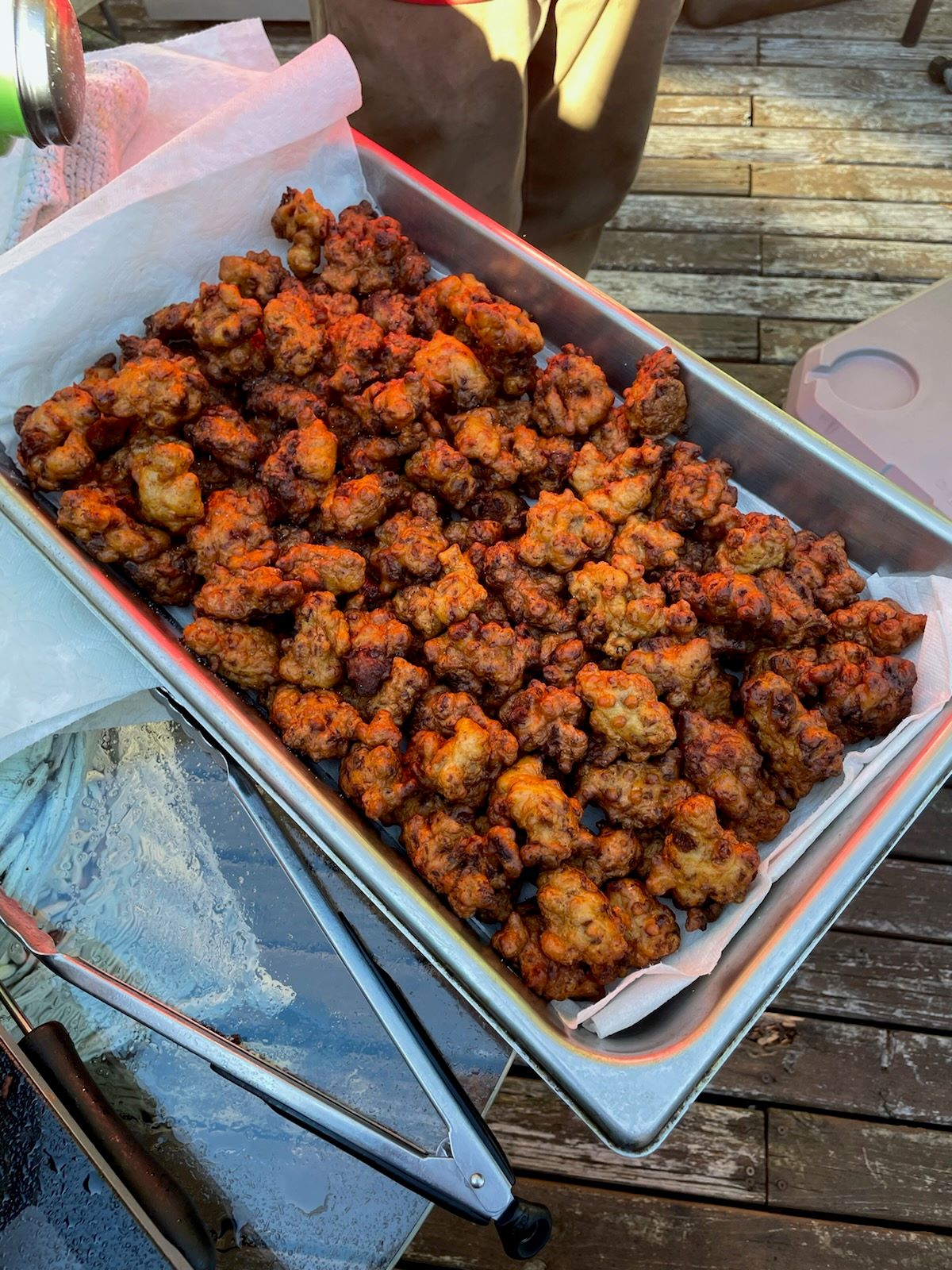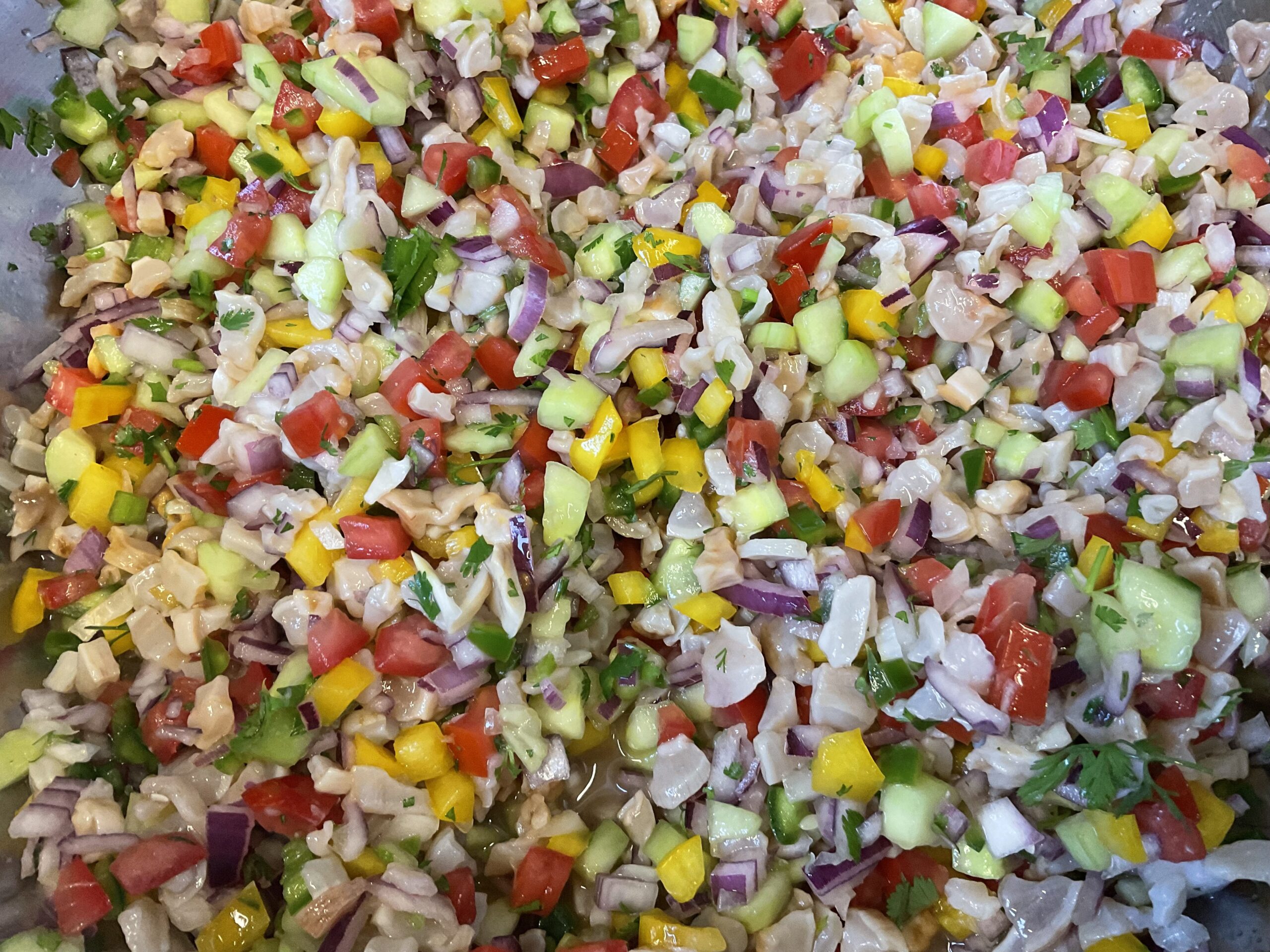
Harvested geoduck clams. Photo Credit: AP Photo/Lindsey Wasson.
Geoducks are large, long-lived clams that can be harvested in the wild from the seafloor and grown through aquaculture methods. These unique shellfish are an important cultural, economic, and ecological resource for some Tribes in Puget Sound, harvested for commercial, ceremonial and subsistence purposes. Members of the Indigenous Aquaculture Network participate in geoduck dive fisheries, including honored members from the Suquamish Tribe and Squaxin Island Tribe.
Suquamish Seafoods oversees the wild harvest of geoduck for commercial sales, while the Tribe’s Fisheries Department Shellfish Program leads stock assessment surveys as well as conservation management for the species.
Each year, scientific divers from the Suquamish Shellfish Program, with the help of commercial geoduck divers, conduct underwater surveys from April through October to assess geoduck populations. The divers count visible siphons and collect sample weights to estimate biomass across harvesting zones. From this data, annual quotas are carefully determined, allowing 2.7% or less of the surveyed biomass to be harvested annually. To ensure the long term sustainability and conservation of this species, 35% of each tract’s pre-harvest biomass is left intact, and tracts are then rested for multiple years to allow natural recovery.
In addition to the stock assessment surveys, the Suquamish Tribe in collaboration with state co-managers, is conducting a geoduck aging study to better understand the age structure and natural mortality rates of geoduck populations in Puget Sound. This study is crucial for sustainable harvest management. The Tribe collected over 800 geoducks from an unharvested tract located in the Suquamish exclusive usual and accustomed (U&A) area, processed the shells for aging analysis, and donated the edible parts to the Tribe’s Elders’ meal program. Similar to counting rings on a tree, geoducks can be aged by counting the rings on their outer shell. With some geoducks living up to nearly 200 years, this long-term data collection aims to improve current harvest models, ensuring this culturally significant species remains for many generations to come.
While geoduck research is critical to understand the long term health of the population, the Suquamish Tribe is also taking proactive measures to safeguard sensitive habitats that coexist with geoduck beds. Divers are also surveying eelgrass beds to determine depth limits, triggering specific harvest restrictions when eelgrass is present to protect these critical marine habitats. These conservation practices reflect the Tribe’s deep commitment to co-managing marine resources in a way that honors cultural traditions, respects ecological systems, and ensures future generations can continue to harvest and steward geoduck in their ancestral waters.
Jay Mills Delicious Geoduck Recipes
To celebrate and honor the geoduck, Suquamish Elder, Jay Mills, was kind enough to share some of his favorite geoduck recipes. In addition to being a Suquamish Tribal Council Member, Jay is also a commercial fisherman with deep expertise in gathering and preserving Salish seafood. For over 50 years, Jay has been harvesting, processing and cooking up delicious seafood. Jay also shares his wealth of knowledge with students at Chief Kitsap Academy, teaching them how to traditionally smoke and can salmon through the Ocean-to-Table project at Suquamish. Oh! And Jay is one of the leaders in our Cross-Pacific Indigenous Aquaculture Collaborative, and we’re grateful to continue to learn from him as well as taste his delicious gifts. Below are Jay’s recipes for geoduck fritters which he made for the Celebrate the Cockle event hosted by the Suquamish Tribe, and a geoduck ceviche recipe. Enjoy!
Geoduck Fritters

Delicious geoduck fritters ready to serve! Photo Credit: Jay Mills
Ingredients:
-
2-3 medium geoduck cleaned and ground in food processor (2 cups Ground) or more
-
2 cups self-rising flour
-
2 eggs well beaten
-
1 medium size onion small diced
-
1 cup milk (approx.)
-
3/4 cup clam nectar (prefer fresh approx.)
-
1/4 teaspoon pepper
-
1/4 teaspoon garlic powder
-
1/4 teaspoon onion powder
Instructions:
All of the ingredients above can be adjusted, the consistency you’re looking for is a thick pancake dough with lots of geoduck and onion; you can add green peppers as well. You can pan fry in vegetable oil, or deep fry in the fryer w/ 2-3 cups vegetable oil at 360-370 degrees. Use two spoons: one to scoop up a tablespoon of batter and the other to push off batter into oil! Be careful when dropping in hot oil! Fry till golden brown sprinkle with sea salt and serve! (Don’t add salt to the batter as the self-rising flour has salt in it.)
Good luck!
Geoduck Ceviche

Fresh and colorful geoduck ceviche. Photo Credit: Jay Mills
Ingredients:
-
1-2 lbs. geoduck, small dice not using the strap
-
½ cup lime juice (approx.)
-
1/8 cup mandarin juice (approx.)
-
1 1/2 cups roma tomatoes, diced
-
1/8-1/4 cup cilantro
-
1/2 cup red onion, diced
-
1/2 cup white sweet onion, diced
-
1-2 jalapeño, diced
-
1 large cucumber, peeled and diced
-
1 medium yellow bell pepper, diced
-
Season to taste with salt and pepper
-
Tabasco sauce
Instructions:
All of these ingredients above can be adjusted. Ensure your diced products above are similar in size. Marinate and chill at least one hour before cooking and serving, stir on occasions ensuring all ingredients are covered in the citrus juice! Serve with tortilla chips!
Enjoy!
